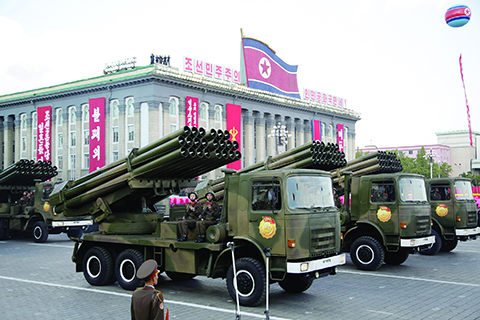 Military equipment is paraded in Pyongyang, North Korea, Saturday, Oct. 10, 2015. North Korean leader Kim Jong Un declared Saturday that his country was ready to stand up to any threat posed by the United States as he spoke at a lavish military parade to mark the 70th anniversary of the North's ruling party and trumpet his third-generation leadership. (AP Photo/Wong Maye-E)
Military equipment is paraded in Pyongyang, North Korea, Saturday, Oct. 10, 2015. North Korean leader Kim Jong Un declared Saturday that his country was ready to stand up to any threat posed by the United States as he spoke at a lavish military parade to mark the 70th anniversary of the North's ruling party and trumpet his third-generation leadership. (AP Photo/Wong Maye-E)PYONGYANG: North Korea's leader Kim Jong-Un said yesterday his country could fight any war provoked by the United States, as he presided over a vast military parade to mark the 70th anniversary of the ruling Workers' Party. Thousands of troops marched through the capital followed by columns of tanks, armored vehicles and ballistic missiles, in what was tipped to be one of the largest ceremonial displays of military strength in North Korea's history.
Dressed in his customary dark Mao suit, Kim struck a more belligerent note than in previous public addresses, telling the assembled masses in Kim Il-Sung square that North Korea could fight any war begun by the US. "Our party dauntlessly declares that our revolutionary armed forces are capable of fighting any kind of war provoked by the US and we are ready to protect our people and the blue sky of our motherland," he said.
His words were met with rapturous applause from tens of thousands of flag-waving spectators, while above the square, a large banner slung from a gas-filled balloon read: "Long live the invincible Workers' Party of Korea." Buildings surrounding the plaza, named after Kim's grandfather, the founding leader of North Korea, were festooned with red hammer-and-sickle party flags and the national colours of blue, white and red. Poor but nuclear-armed North Korea often threatens to destroy the US and
South Korea, with which it technically remains at war after their 1950-53 conflict ended in a truce, not a treaty. The North remains deeply politically isolated on the world stage, and its closest ally China was the only country to send a diplomat to Saturday's event.
'Cutting-edge' weapons
As night fell after the parade-a tribute to the ruling party that has served at the whim of three generations of the Kim dynasty-the skies of Pyongyang were lit up with a fireworks display over the banks of the Taedong River. On the ground, roaring crowds held up their coloured squares to create huge images of Worker Party flags and spelling out the name of Kim Jong-Un.
The scale of the event was already apparent from satellite images taken four days before which showed a sprawling training ground in Pyongyang featuring some 800 tents, 700 trucks and 200 armored vehicles. When announcing plans for the "grand-style" parade back in February, the ruling party's top decision-making body had stressed the importance of "cutting-edge" weaponry suitable for modern warfare. North Korea has conducted three nuclear tests and threatened a fourth as part of a nuclear weapons and missile program that it has pursued through a barrage of international sanctions.
There is debate among experts as to how far it has come in developing those weapons, especially the ability to shrink nuclear warheads so that they can fit on a missile. An exhaustively researched report published this week by the US-based Institute for Science and International Security estimated that North Korea had between 10 and 16 nuclear weapons as of the end of 2014. The report argued it was likely the country could already build a warhead to fit atop a Nodong missile-with a range of less than 800 miles (1,300 kilometres) -- but added that the reliability of such a weapon was open to question.
10-10
Months of planning and preparation have gone into yesterday's celebrations, involving a mass mobilization of state personnel and resources to ensure its success. The capital was given a comprehensive makeover-its streets lined and decorated with giant posters, red banners and national flags, many of them displaying the numerals "10-10" in reference to the ruling party's official October 10 birthday.
The North excels at such choreographed displays of military muscle, which aim to boost pride and patriotism at home while sending a defiant message to an international community that has sought, without success, to pressure Pyongyang into abandoning its nuclear weapons ambitions. But they also reflect North Korea's diplomatic isolation, and Chinese party politburo standing committee member Liu Yunshan was the only foreign dignitary of any significance attending Saturday's event. Kim and Liu met for talks on Friday, during which the Chinese official delivered a letter from President Xi Jinping, and voiced Beijing's willingness to work with Pyongyang on resuming multi-party talks on its nuclear program.
"The DPRK (North Korea) is willing to make efforts to improve relations between the North and the South and safeguard the stability of the peninsula", Xinhua reported the young leader as saying. China remains North Korea's most important diplomatic ally and economic partner, even as Beijing has grown increasingly wary and impatient with Pyongyang's nuclear weapons ambitions. - AFP










